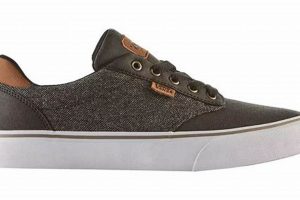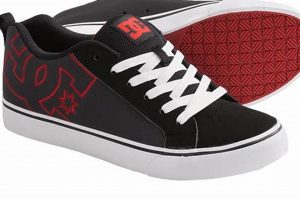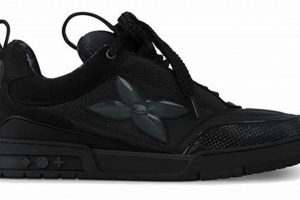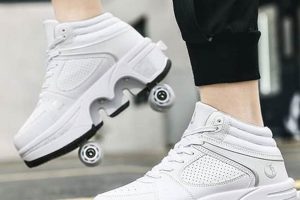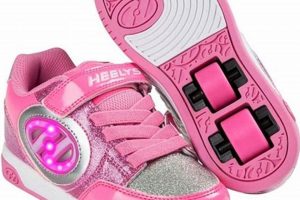Footwear specifically designed for skateboarding constitutes a critical element in the sport. This specialized equipment provides the necessary grip, board feel, and protection that standard athletic shoes often lack. For instance, models constructed with flat, vulcanized rubber soles offer superior adhesion to the skateboard deck, while reinforced stitching and durable materials withstand the abrasive nature of skateboarding.
The utilization of appropriate equipment enhances performance, reduces the risk of injury, and contributes to the overall longevity of both the user and the skateboard. The development of such footwear has significantly impacted the evolution of skateboarding, allowing for more complex maneuvers and greater control. Historically, improvements in design and materials have mirrored advancements in skateboarding techniques and styles.
Understanding the specific features and benefits of this specialized footwear is essential for participants of all skill levels. The following sections will delve into material compositions, design considerations, and the selection process to ensure an optimal skateboarding experience.
Tips for Selecting Skateboarding Footwear
Choosing the correct footwear significantly impacts a skateboarder’s performance, safety, and comfort. The following tips outline key considerations for selecting appropriate skateboarding footwear.
Tip 1: Prioritize Sole Construction: Vulcanized rubber soles are commonly preferred due to their flexibility and superior grip. Cupsole constructions offer increased durability and impact protection, particularly beneficial for skaters engaging in high-impact maneuvers.
Tip 2: Evaluate Material Durability: Suede and leather are frequently used materials due to their resistance to abrasion. Consider the thickness and quality of the material, especially in high-wear areas like the toe and ollie patch.
Tip 3: Assess Ankle Support: High-top models provide enhanced ankle support, minimizing the risk of sprains and injuries. Low-top models offer greater freedom of movement but less ankle protection. Choose based on personal preference and skating style.
Tip 4: Inspect Stitching Reinforcement: Look for double or triple stitching in areas prone to stress, such as the seams and ollie patch. Reinforced stitching enhances the lifespan of the footwear, preventing premature wear and tear.
Tip 5: Consider Insole Cushioning: Adequate insole cushioning absorbs impact, reducing foot fatigue and preventing injuries. Look for insoles with shock-absorbing properties, particularly if frequently performing tricks involving jumps and landings.
Tip 6: Ensure Proper Fit: The footwear should fit snugly but not restrictively, allowing for optimal board feel and control. Avoid excessively loose or tight footwear, as this can compromise performance and increase the risk of blisters.
Adhering to these selection criteria will significantly improve the skateboarding experience, enhancing both performance and safety.
The following sections will further explore the maintenance and care of skateboarding footwear to maximize its lifespan and performance.
1. Grip
Grip, in the context of skateboarding footwear, is the frictional force generated between the sole of the footwear and the skateboard deck. This force directly influences the skater’s ability to maintain control, execute maneuvers, and prevent slippage. The sole material, typically vulcanized rubber, and the tread pattern are key determinants of grip efficacy. Insufficient grip compromises board control, increasing the likelihood of falls and failed tricks. For instance, a skater attempting an ollie on a slick surface, or with worn soles, will experience reduced grip, hindering the ability to pop the tail effectively and maintain balance.
The level of grip required varies depending on the skateboarding style and terrain. Street skaters often prioritize a balance between grip and board feel, allowing for precise foot placement and control during technical tricks. Vert skaters, on the other hand, may prefer maximum grip to maintain stability on ramps and prevent slippage during high-speed maneuvers. Furthermore, environmental conditions such as moisture or debris can significantly impact grip performance, necessitating adjustments in technique or footwear selection. The design and materials are carefully selected to balance durability with optimal surface adhesion.
Effective grip is a fundamental component of skateboarding footwear, directly impacting performance, safety, and control. Understanding the factors influencing grip, such as sole material, tread pattern, and environmental conditions, allows skaters to make informed equipment choices and adjust their technique accordingly. A consistent grip mitigates risk and enhances the skater’s capacity to perform effectively.
2. Durability
Durability, in the context of skateboarding footwear, directly correlates with the longevity and sustained performance of the equipment. The abrasive nature of skateboarding subjects footwear to significant stress, necessitating robust construction and resilient materials.
- Material Composition
The selection of materials such as suede, leather, and reinforced canvas directly influences durability. Suede provides abrasion resistance and flexibility, while leather offers greater structural integrity. Reinforced canvas enhances durability in high-wear areas, preventing premature failure. The strategic combination of these materials contributes to the overall lifespan.
- Stitching Techniques
Reinforced stitching, including double or triple stitching, strengthens critical seams and stress points. This prevents separation of components and extends the lifespan of the footwear under demanding conditions. Inadequate stitching compromises structural integrity, leading to rapid deterioration.
- Sole Construction Methods
Vulcanized soles, known for their flexibility and grip, often exhibit lower durability compared to cupsole constructions. Cupsole designs offer enhanced impact protection and structural support, increasing resistance to wear and tear. The choice of sole construction depends on the skater’s style and the level of impact experienced.
- Abrasion Resistance
Specific treatments and coatings can enhance the abrasion resistance of materials used in construction. These treatments protect against scuffing and wear caused by contact with the skateboard deck and rough surfaces. Enhanced abrasion resistance translates to a longer-lasting and more reliable product.
The interplay of material selection, construction techniques, and abrasion resistance determines the overall durability of skateboarding footwear. Prioritizing durability ensures that the equipment withstands the rigorous demands of skateboarding, providing sustained performance and mitigating the need for frequent replacements.
3. Boardfeel
Boardfeel, in the context of skateboarding footwear, represents the tactile sensitivity transmitted from the skateboard deck to the skater’s feet. This sensory feedback enables precise control and nuanced adjustments during maneuvers. Footwear designed with enhanced boardfeel typically features thinner soles, often constructed from flexible materials, allowing for a more direct connection to the board. A reduction in sole thickness and increased flexibility improves the skater’s ability to perceive the board’s position and angle, facilitating quicker responses and more accurate execution of tricks. For example, a skater performing a kickflip relies on boardfeel to gauge the rotation of the board underfoot and make subtle adjustments to maintain balance upon landing. Footwear that dampens or obscures this sensory feedback can hinder performance, leading to decreased control and increased risk of misexecution.
The importance of boardfeel extends beyond trick execution. It is also crucial for navigating varied terrains and maintaining stability at different speeds. A skater cruising down a street relies on boardfeel to detect subtle changes in the pavement surface and adjust their weight accordingly. Similarly, when riding ramps or bowls, boardfeel allows skaters to sense the transition between different planes, enabling smooth and controlled movements. The selection of footwear with appropriate boardfeel characteristics is therefore highly dependent on the individual skater’s style, experience level, and the type of skateboarding being practiced. The ability to feel the board directly impacts the connection and control a skater has over their equipment.
Ultimately, boardfeel constitutes a critical element in the design and selection of skateboarding footwear. While durability and protection remain essential considerations, the level of tactile sensitivity afforded by a given shoe can significantly influence a skater’s performance and overall experience. Understanding the relationship between footwear construction and boardfeel empowers skaters to make informed choices, optimizing their control and facilitating progression. Challenges remain in balancing boardfeel with other performance factors, such as impact protection, requiring ongoing innovation in materials and design. The pursuit of enhanced boardfeel aligns with the broader goal of maximizing the synergy between skater and equipment, promoting both skill development and safety.
4. Protection
Protection is a paramount consideration in the design and selection of skateboarding footwear. The inherent risks associated with skateboarding necessitate specialized footwear that mitigates potential injuries. Several facets of design and construction contribute to the protective capabilities of “shoes skate”.
- Ankle Support
High-top designs and reinforced ankle collars provide crucial support to the ankle joint, reducing the likelihood of sprains and strains. Skaters performing aerial maneuvers or navigating uneven terrain benefit significantly from enhanced ankle support. Without adequate support, the ankle is vulnerable to injury during landings or unexpected impacts.
- Impact Cushioning
Midsole cushioning, often incorporating specialized materials like polyurethane or EVA foam, absorbs impact forces generated during landings and tricks. This cushioning reduces stress on the feet, ankles, and knees, mitigating the risk of stress fractures and joint pain. Insufficient cushioning can lead to chronic injuries and reduced performance.
- Toe Reinforcement
Reinforced toe caps, typically constructed from durable materials like rubber or leather, protect the toes from abrasion and impact. This reinforcement is particularly important for skaters who frequently perform ollies and other flip tricks, where the toe area experiences significant wear. Failure to protect the toes can result in painful abrasions and injuries.
- Sole Durability
A robust outsole, constructed from abrasion-resistant rubber compounds, provides a protective barrier against sharp objects and rough surfaces. This protects the plantar surface of the foot from punctures and lacerations. Insufficient sole durability can compromise foot safety, particularly when skating in urban environments.
The integration of these protective features in “shoes skate” directly contributes to skater safety and performance. The absence or inadequacy of any one of these features can increase the risk of injury, underscoring the importance of selecting footwear specifically designed to address the demands of skateboarding. Balancing protection with boardfeel and durability remains a central challenge in footwear design, necessitating careful consideration of materials and construction techniques.
5. Ankle Support
Ankle support is a critical design component within skateboarding footwear, serving as a primary defense against ankle injuries. The repetitive stress and high-impact landings inherent in skateboarding place considerable strain on the ankle joint, making adequate support a necessity. Footwear lacking sufficient ankle support elevates the risk of sprains, strains, and more severe ligament damage. The degree of support is commonly achieved through high-top designs, reinforced padding around the ankle collar, and the use of stiffer materials in the upper construction. These features collectively restrict excessive lateral movement, stabilizing the ankle during demanding maneuvers.
Consider the scenario of a skater attempting a complex trick involving a missed landing. In such cases, the ankle is subjected to sudden and unnatural angles. Footwear with robust ankle support can effectively mitigate the severity of the impact, preventing or minimizing injury. Conversely, low-cut footwear or designs lacking adequate reinforcement offer minimal protection, leaving the ankle vulnerable. The selection of appropriate footwear should, therefore, be guided by the skater’s experience level, skating style, and the potential for high-impact landings. Skaters who frequently perform aerial tricks or navigate uneven terrain require a higher degree of ankle support than those who primarily focus on flat-ground maneuvers.
The integration of ankle support features into skateboarding footwear represents a direct response to the biomechanical demands of the sport. While prioritizing ankle support is essential for injury prevention, it’s crucial to balance this consideration with other factors such as boardfeel and flexibility. The optimal design achieves a harmonious equilibrium, providing adequate support without unduly restricting movement or diminishing the skater’s connection to the board. The development of innovative materials and construction techniques continues to drive advancements in ankle support technology, enhancing both skater safety and performance.
6. Construction
The construction of skateboarding footwear is a multifaceted process directly influencing its performance, durability, and protective capabilities. It encompasses the materials used, the manufacturing techniques employed, and the integration of various components into a cohesive whole. Understanding the construction intricacies is crucial for assessing the suitability of a particular model for specific skateboarding styles and conditions.
- Sole Adhesion Methods
The method by which the sole is attached to the upper significantly impacts the footwear’s longevity and flexibility. Vulcanization, a process involving heat and pressure to bond rubber to fabric, offers superior flexibility and boardfeel but may be less durable than cupsole construction, where the sole is stitched and glued to the upper, providing enhanced impact protection and structural integrity. Choice dictates shoe behavior.
- Material Selection and Reinforcement
The selection of materials, such as suede, leather, and canvas, dictates the shoe’s resistance to abrasion and tearing. Strategic reinforcement of high-wear areas, such as the toe cap and ollie patch, with additional layers of material or durable stitching enhances the shoe’s lifespan and protects the skater’s foot. Improper material use leads to fast wear and tear.
- Stitching and Seam Reinforcement
The quality and density of stitching directly affect the footwear’s structural integrity. Double or triple stitching, particularly in high-stress areas, prevents seams from separating under duress. Reinforced seams minimize the risk of failure, extending the shoe’s usability. Weak stitching causes shoe to fall apart easily.
- Insole and Midsole Technology
The composition and design of the insole and midsole contribute significantly to impact absorption and comfort. Insoles featuring cushioning materials, such as polyurethane or gel, reduce impact forces on the foot and joints. Midsole technologies, such as encapsulated air pockets or foam layers, further enhance shock absorption and provide additional support. Inferior tech leads to discomfort.
The interplay of these construction elements determines the overall performance and durability of skateboarding footwear. A well-constructed shoe, employing appropriate materials and manufacturing techniques, provides skaters with the support, protection, and boardfeel necessary to perform at their best while minimizing the risk of injury. The proper construction and careful selection of each component are essential to ensuring a high-quality, durable, and effective skating shoe.
Frequently Asked Questions
The following addresses common inquiries regarding the selection, use, and maintenance of skateboarding footwear. The information provided aims to enhance understanding and optimize performance.
Question 1: What distinguishes dedicated skateboarding footwear from general athletic footwear?
Dedicated skateboarding footwear is specifically engineered to withstand the abrasive forces and high-impact conditions inherent in skateboarding. Key differentiators include reinforced construction, durable materials, and specialized sole designs optimized for grip and boardfeel. General athletic footwear often lacks these features, resulting in premature wear and reduced performance.
Question 2: How frequently should skateboarding footwear be replaced?
The lifespan of skateboarding footwear depends on several factors, including the skater’s style, frequency of use, and the quality of the footwear. Signs of wear, such as sole separation, fabric tears, or diminished cushioning, indicate the need for replacement. Regular inspection and timely replacement are crucial for maintaining performance and preventing injuries.
Question 3: What is the significance of vulcanized soles in skateboarding footwear?
Vulcanized soles offer superior flexibility and boardfeel, allowing for precise control and nuanced adjustments. The vulcanization process creates a strong bond between the rubber sole and the upper, providing durability and responsiveness. This construction is commonly preferred by skaters who prioritize boardfeel and maneuverability.
Question 4: How should skateboarding footwear be cleaned and maintained?
Regular cleaning with a soft brush and mild soap helps remove dirt and debris, prolonging the life of skateboarding footwear. Avoid harsh chemicals or abrasive cleaners, which can damage the materials. Air drying is recommended to prevent shrinkage or warping. Protective coatings can also be applied to enhance water resistance and prevent staining.
Question 5: What role does ankle support play in skateboarding footwear?
Ankle support is a crucial feature that minimizes the risk of sprains and strains. High-top designs and reinforced ankle collars provide stability and restrict excessive lateral movement. Skaters who frequently perform aerial maneuvers or navigate uneven terrain benefit significantly from enhanced ankle support.
Question 6: How does sole construction influence performance?
The sole construction directly affects grip, boardfeel, and impact protection. Vulcanized soles offer superior flexibility and boardfeel, while cupsole constructions provide enhanced durability and cushioning. The selection of sole construction should align with the skater’s style and the demands of the terrain.
Proper understanding of the factors discussed above can inform the effective selection, maintenance, and utilization of skateboarding footwear. Adherence to these guidelines promotes skater safety and performance.
The following section will explore the future trends and innovations in skateboarding footwear technology.
Conclusion
The preceding exploration has elucidated the critical role of specialized footwear within the context of skateboarding. Durability, grip, boardfeel, and protection were identified as core attributes that differentiate purpose-built skateboarding footwear from conventional athletic shoes. The optimization of these attributes, through material selection, construction techniques, and design innovations, directly impacts skater performance, safety, and the longevity of the equipment itself. This analysis underscores the importance of informed decision-making when selecting footwear for skateboarding, emphasizing the need to consider individual skating styles, environmental conditions, and the potential for high-impact scenarios.
Recognizing the sustained influence of appropriate footwear on the skateboarding experience, ongoing research and development are paramount. Continued innovation in materials science and manufacturing processes offers the potential to further enhance the performance characteristics and protective capabilities of these essential components. Stakeholders, including manufacturers, designers, and skaters, are encouraged to prioritize advancements that promote both safety and skill progression within the skateboarding community. Investment in, and adoption of, such advancements will be instrumental in shaping the future of this dynamic sport.


